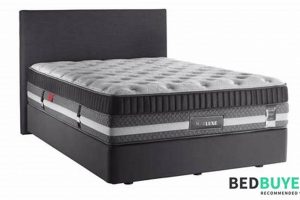The selection of a sleep surface significantly impacts the rest and well-being of individuals with higher body weights. Support, durability, and temperature regulation are crucial factors in determining the suitability of a mattress for this demographic. A product designed for general use may lack the necessary features to provide adequate comfort and spinal alignment for a person carrying extra weight.
Proper mattress selection contributes to improved sleep quality, reduced pressure points, and enhanced musculoskeletal health. Historically, heavier individuals often faced limited options, resulting in discomfort and potential health issues. Modern mattress technology has led to advancements in materials and construction methods, offering more specialized solutions. The availability of mattresses engineered to withstand greater compression and provide targeted support has positively impacted the sleep experience for this group.
This discussion explores key considerations when choosing a mattress, including construction materials, firmness levels, and support systems. It will delve into specific mattress types known for their suitability, outlining the features that contribute to optimal comfort and long-term durability for individuals with higher body weights.
Essential Considerations for Mattress Selection
The subsequent guidance offers pivotal insights to inform the selection process. These recommendations prioritize support, longevity, and thermal regulation.
Tip 1: Prioritize Innerspring or Hybrid Models: Mattresses incorporating innerspring or hybrid designs tend to offer enhanced support due to the coil system. These coils distribute weight more effectively, reducing sagging and promoting proper spinal alignment.
Tip 2: Evaluate Coil Gauge: Lower coil gauges (e.g., 12-13) indicate thicker, more durable coils. A higher gauge coil offers greater resistance to compression, resulting in enhanced long-term support and preventing premature wear.
Tip 3: Consider High-Density Foam Layers: When present, high-density foam in comfort or support layers improves overall mattress durability. The increased density withstands pressure, preventing body impressions and maintaining a consistent sleep surface.
Tip 4: Examine Edge Support Construction: Reinforced edges mitigate the likelihood of edge collapse, which can be a common issue in lower-quality mattresses. Stronger edge support also expands the usable sleep surface.
Tip 5: Assess Firmness Level Carefully: While personal preference varies, a firmer mattress generally provides superior support and prevents excessive sinkage. Medium-firm to firm options are often more suitable to ensure adequate spinal alignment.
Tip 6: Inquire About Weight Capacity: Manufacturers frequently specify weight limits for their mattresses. Verification that the mattresss specified capacity exceeds the user’s weight is crucial for ensuring longevity and warranty validity.
Tip 7: Research Temperature Regulation Features: Overheating can disrupt sleep. Mattresses with breathable materials like open-cell foam or those incorporating cooling technologies may enhance comfort and minimize temperature-related sleep disturbances.
Adhering to these recommendations will likely result in a more supportive and durable sleep surface, ultimately promoting improved rest and minimizing potential discomfort. These points lay the groundwork for the concluding assessment of mattress options.
These key elements provide a solid basis for finding a mattress that offers lasting comfort and support.
1. Reinforced Edge Support
Reinforced edge support is a critical feature in a mattress designed for individuals with higher body weights, directly affecting the usable sleep surface and long-term mattress durability.
- Expanded Sleep Surface
Without adequate edge support, the perimeter of a mattress tends to compress, reducing the available area for sleep. Reinforced edges prevent this compression, allowing individuals to utilize the full width of the mattress comfortably. This is particularly beneficial for those who may naturally gravitate towards the edges of the bed or share the mattress with a partner.
- Enhanced Stability
Strong edge support provides greater stability when sitting on the edge of the mattress. This is significant for individuals who may use the edge of the bed for dressing or simply sitting. Without reinforcement, the edge can collapse under weight, creating a safety hazard and accelerating wear on the mattress.
- Improved Weight Distribution
Reinforced edges contribute to a more even distribution of weight across the entire mattress surface. This prevents excessive stress on the central areas, reducing the likelihood of sagging and maintaining proper spinal alignment, even when sleeping near the edge.
- Increased Mattress Longevity
By preventing edge collapse and maintaining structural integrity, reinforced edge support significantly extends the lifespan of the mattress. This is especially important for mattresses intended to support higher body weights, as they are subject to greater stress and compression over time. The reinforcement prevents premature wear and maintains the overall support and comfort of the mattress.
In conclusion, reinforced edge support is not merely a cosmetic feature but a functional necessity for ensuring a comfortable, safe, and durable sleep surface. Its presence directly correlates with the suitability of a mattress for individuals with higher body weights, providing tangible benefits in terms of usable space, stability, weight distribution, and mattress longevity.
2. High-density foam layers
High-density foam layers play a crucial role in the construction of a mattress suitable for individuals carrying additional weight. The increased density of the foam directly correlates with the mattress’s ability to provide adequate support and maintain its structural integrity over time. Lower density foams compress more readily under pressure, leading to sagging and a loss of support, particularly in areas where the majority of the weight is concentrated. In contrast, high-density foam resists compression, ensuring a consistent sleep surface and promoting proper spinal alignment. For example, a mattress with a comfort layer made of low-density polyurethane foam will likely develop body impressions more quickly than a mattress with a high-density memory foam or latex comfort layer. The result is diminished comfort and potential musculoskeletal issues for the user.
The practical significance of using high-density foam extends beyond immediate comfort. Mattresses with high-density foam layers exhibit increased durabili
ty, resisting premature wear and tear. This is a cost-effective measure in the long term, as a mattress constructed with higher-quality materials requires less frequent replacement. Furthermore, high-density foam often provides enhanced motion isolation, a valuable feature for couples sharing a bed. The foam’s ability to absorb and dissipate movement prevents disturbances caused by one partner from affecting the other’s sleep. Examples of high-density foams often found in mattresses designed for heavier individuals include high-density memory foam, Dunlop latex, and certain types of high-density polyfoam.
In summary, the inclusion of high-density foam layers is a critical design consideration when selecting a mattress. The challenges associated with insufficient support and premature sagging in lower-density alternatives necessitate a focus on materials that can withstand significant compression while maintaining their shape and providing consistent support. This attribute is central to the overall suitability and longevity of the mattress, directly impacting the quality of sleep and the long-term health of the individual using it.
3. Appropriate coil gauge
Coil gauge, measured numerically, indicates the thickness of the individual coils within an innerspring mattress. Lower gauge numbers denote thicker coils, translating to enhanced durability and support, an essential attribute for a mattress intended for individuals with higher body weights. A mattress lacking appropriate coil gauge exhibits compromised structural integrity, leading to premature sagging and uneven weight distribution. This directly undermines spinal alignment, potentially exacerbating musculoskeletal issues. For instance, a mattress with a coil gauge of 15 may prove inadequate, resulting in noticeable indentation and discomfort for a heavier individual over time, versus a mattress with a 12-gauge coil providing necessary support.
The practical implications of selecting a mattress with a suitable coil gauge extend beyond immediate comfort. A properly gauged coil system ensures consistent support across the entire sleep surface, mitigating pressure points and promoting restful sleep. It resists compression, preventing the mattress from losing its shape and support capabilities over its lifespan. Furthermore, a robust coil system enhances motion isolation, reducing sleep disturbances caused by movement. For example, when a heavier individual shifts position during the night, a mattress with appropriately gauged coils minimizes motion transfer to a sleeping partner, thereby fostering uninterrupted rest. The resilience of the coils contributes to the mattress’s long-term performance, preserving its structural integrity and preventing the development of indentations that compromise support and comfort.
In summary, the selection of an appropriate coil gauge is integral to the overall suitability of a mattress. The challenges associated with inadequate support and premature wear in mattresses with higher gauge coils necessitate a focus on lower gauge options that deliver superior durability and consistent support. The coil gauge is a key element in determining the long-term performance and comfort of a mattress and plays a pivotal role in optimizing the sleep experience.
4. Firmness level selection
Firmness level selection represents a critical determinant in optimizing sleep quality and musculoskeletal health, particularly for individuals with higher body weights. The relationship between firmness and support directly influences spinal alignment and pressure point distribution. A sleep surface lacking sufficient firmness may result in excessive sinking, leading to spinal misalignment and increased pressure concentration. Conversely, an excessively firm mattress may fail to conform to the body’s contours, generating pressure points and discomfort. Therefore, the selection of an appropriate firmness level becomes paramount in achieving a balanced and supportive sleep environment. For instance, a person with a body mass index (BMI) exceeding 30 may benefit from a medium-firm or firm mattress to prevent spinal compression, while an individual of average weight might find a softer mattress more comfortable.
The practical significance of informed firmness level selection extends beyond immediate comfort. Proper spinal alignment reduces the likelihood of back pain and stiffness, contributing to improved daytime function and overall quality of life. Furthermore, adequate pressure point distribution minimizes the risk of developing pressure ulcers, particularly in individuals with limited mobility. The ideal firmness level should facilitate even weight distribution, preventing localized stress on joints and soft tissues. Considering individual preferences and sleeping positions is essential; side sleepers may require a slightly softer surface to accommodate shoulder and hip contours, while back sleepers typically benefit from a firmer surface to maintain spinal curvature.
In summary, the appropriate firmness level selection is an indispensable component when choosing a mattress. The challenges arising from selecting an unsuitable firmness can lead to discomfort, pain, and compromised sleep quality. A thoughtful evaluation of individual needs, body weight, and sleeping preferences enables the selection of a sleep surface that provides optimal support, promotes spinal alignment, and contributes to long-term musculoskeletal health. The success of a mattress is directly related to the appropriate firmness matched to the individual’s needs.
5. Adequate weight capacity
Adequate weight capacity is a foundational element in determining the suitability of a mattress for individuals with higher body weights. Overlooking this specification can compromise both the sleep experience and the longevity of the mattress itself.
- Structural Integrity
A mattress lacking sufficient weight capacity will experience accelerated wear and tear, leading to sagging and reduced support. The internal components, such as coils and foam layers, are subjected to stresses beyond their design parameters, resulting in premature degradation. For instance, a mattress rated for 250 pounds used regularly by an individual weighing 300 pounds will likely exhibit significant compression and loss of support within a relatively short timeframe. This compromises spinal alignment and overall comfort.
- Warranty Validity
Mattress warranties often include stipulations regarding weight limits. Exceeding the manufacturer’s specified weight capacity typically voids the warranty, leaving the purchaser without recourse in the event of premature failure. Therefore, confirming that the mattress’s weight capacity exceeds the intended user’s weight is crucial for ensuring long-term protection and investment value.
- Consistent Performance
A mattress with an appropriate weight capacity maintains consistent performance characteristics over its lifespan. The support system effectively distributes weight, preventing localized pressure points and promoting proper spinal alignment. This translates to improved sleep quality and reduced risk of musculoskeletal discomfort. In
contrast, a mattress pushed beyond its limits will exhibit uneven support, leading to discomfort and potential health issues. - Material Composition
Weight ratings are related to the density and design of the material used. The material and its design are important. A mattress designed to withstand additional weight will include a greater coil count, stronger gauge coils, or reinforced materials. Therefore a higher rating usually implies superior material selection. Choosing a higher weight rating provides more comfort and long term use.
The selection of a mattress with adequate weight capacity is not merely a matter of comfort, but a practical necessity for ensuring long-term support, warranty coverage, and overall value. Aligning the mattress’s specified weight limit with the user’s weight is a fundamental step in selecting a sleep surface that delivers lasting performance and promotes restful sleep.
Frequently Asked Questions
The following addresses common inquiries regarding mattress selection for individuals with higher body weights. Emphasis is placed on providing factual information and practical guidance.
Question 1: Is a specialized mattress necessary for individuals with higher body weights?
While not mandatory, a specialized mattress is highly recommended. Standard mattresses may lack the support and durability required to accommodate increased weight, potentially leading to discomfort, spinal misalignment, and premature wear.
Question 2: What firmness level is most suitable?
Generally, medium-firm to firm mattresses are advisable. These firmness levels offer enhanced support and prevent excessive sinking, which can compromise spinal alignment. Individual preferences and sleeping positions should also be considered.
Question 3: How does coil gauge impact mattress performance?
Coil gauge refers to the thickness of the mattress coils. Lower gauge numbers indicate thicker coils, providing greater support and durability. Mattresses intended for individuals with higher body weights should ideally feature lower gauge coils.
Question 4: Are foam mattresses suitable for individuals with higher body weights?
Foam mattresses can be suitable, provided they incorporate high-density foam layers. High-density foam resists compression and maintains support over time. Low-density foam should be avoided, as it is prone to sagging.
Question 5: What role does edge support play?
Reinforced edge support prevents edge collapse, expanding the usable sleep surface and enhancing stability. This feature is particularly beneficial for individuals who sleep near the edge of the bed or require assistance getting in and out of bed.
Question 6: How important is weight capacity?
Weight capacity is a critical factor. Selecting a mattress with a weight capacity that exceeds the intended user’s weight ensures optimal support and prevents premature wear. Exceeding the weight limit may also void the warranty.
This FAQ section provides essential information for making an informed decision regarding mattress selection. Prioritizing support, durability, and weight capacity is paramount.
The next section outlines specific mattress types that are commonly recommended for individuals with higher body weights.
Selecting the Best Mattress for Overweight Person
This exploration has clarified critical factors influencing mattress selection for individuals with higher body weights. Structural integrity, support systems, and material composition are paramount considerations. Coil gauge, foam density, and weight capacity directly impact mattress durability and the user’s sleep quality. Prioritizing these aspects mitigates the risk of premature sagging, spinal misalignment, and compromised sleep.
The information presented enables informed decision-making, promoting long-term comfort and musculoskeletal health. Prospective buyers should meticulously evaluate mattress specifications and assess individual needs to ensure a supportive and resilient sleep surface. Adherence to these guidelines represents a significant investment in overall well-being.


![Top-Rated: Choosing the Best Mattress Foundation [Guide] Organic & Natural Mattress Buyer’s Guide: Non-Toxic Sleep Solutions Top-Rated: Choosing the Best Mattress Foundation [Guide] | Organic & Natural Mattress Buyer’s Guide: Non-Toxic Sleep Solutions](https://mattressworldpa.com/wp-content/uploads/2025/07/th-7633-300x200.jpg)




![How to Find the Best Way Twin Air Mattress [Guide] Organic & Natural Mattress Buyer’s Guide: Non-Toxic Sleep Solutions How to Find the Best Way Twin Air Mattress [Guide] | Organic & Natural Mattress Buyer’s Guide: Non-Toxic Sleep Solutions](https://mattressworldpa.com/wp-content/uploads/2025/07/th-7628-300x200.jpg)